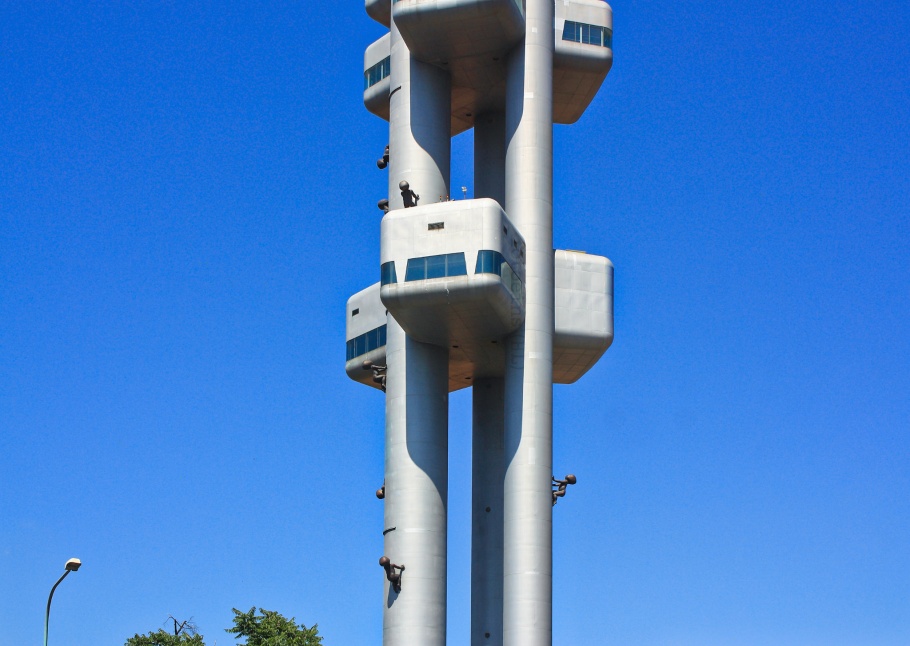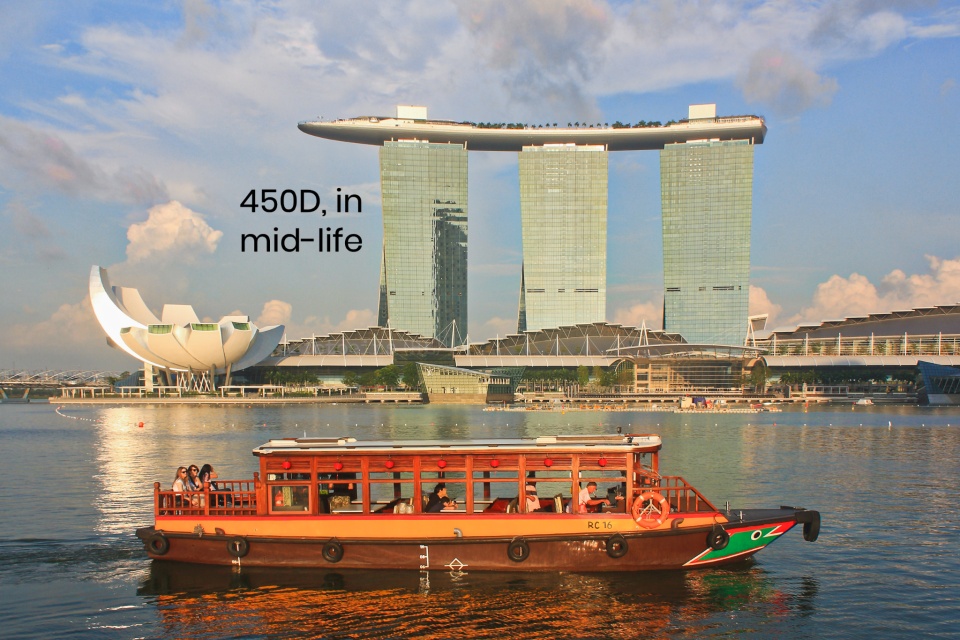450D: the 75000 most important clicks with my camera
Above/featured: Singapore, 3 Jul 2012 (no. 37629).
For the seventh time, I’ve “flipped” or “rolled over” the four-digit image-counter on my camera. I’ve made over 70-thousand exposures, which is a great accomplishment for both camera and me. Unfortunately, exposure number 75000 will prove to be a bad omen.
I own a Canon EOS450D (Rebel XSi), an entry-level digital crop-sensor camera which was introduced to the consumer market in the first-quarter of 2008.
The camera has no weather-proofing, poor to average low-light capability, and a small burst-rate, but the camera is affordable, portable, and easy to use. The kit-lens doesn’t have great build-quality, but the lens is lightweight with a decent range in focal lengths for my kind of photography.
But, all good things must come to an end.
The camera is dead! Long live the camera!
It’s early August 2013, and I’m in the Czech capital city of Prague. I’m standing in front of the Television Tower in the Zizkov neighbourhood.
I’m wearing a confused frown, because the photos are coming out vignetted. I realize quickly the metal leaves which make up the shutter have gone loose, and aren’t opening and closing properly: something like this.
The dreaded error message “Err 99” pops up on the camera display. I turn the power off and on, and press the shutter button. “Err 99” persists, and there’s a new grinding “whirring” noise inside the camera.
Just a couple of days ago, I’ve reached the milestone of exposure number 75000. But apparently, I’ve now reached the end: after 5 years and 2 months, my camera has stopped working.
Why so many clicks? What’s the point?
Some have asked: “Why did you take so many exposures? If you took fewer photos, your camera could’ve lasted longer!”
These questions miss the point of owning a camera.
Making so many exposures is how I got used to the camera. I wouldn’t have to think about what to do, or to figure out what button was where. After frequent use and learning the “manual” functions of my camera, shooting became almost “automatic.” When the moment came, it took a few quick movements to fiddle with the camera settings with “finger-memory” to make the shot.
How does one become good with their camera?
Go out and make lots of photos. Learn, use, and memorize the camera functions. Work on small projects to photograph to get better: explore, screw up and fail spectacularly. Learn, improve, repeat.
Shoot, shoot, and shoot some more, so that getting the shot is first nature, and making the shot is second nature.
That’s also what David duChemin describes in “Towards Mastery. Again”, about becoming proficient with your own camera gear, whatever gear you might have.
Exit stage right
The broken shutter assembly needs replacing, and judging by what I’ve read online, the cost of parts and labour is equivalent to a significant fraction of the price for a new camera or a new piece of glass. The shutter isn’t worth replacing.
So, what’s next? I have no intention on going back to a crop-sensor, so future conversations will involve the phrases “full-frame” and “better low-light performance.”
Goodbye, 450D: you’ve been a trusty servant and guide on my photographic journey.
To celebrate and mourn its passing, here are the first and last photos I made with the 450D.

One of the first images (no. 32): Waikoloa Beach, Big Island of Hawaii – 19 May 2008.

One of the last images (no. 75174): Žižkov TV Tower and “Miminka” (“Babies”), by David Černý, in Prague – 4 Aug 2013.
PostScript: The autofocus ring on the “original” EF-S 18-55mm IS kit-lens failed while I was about to visit New Zealand’s Milford Sound. I purchased a replacement EF-S 18-55mm IS II lens weeks later in Sydney, Australia. This type of lens cannot be used on a full-frame camera. Fortunately, that latter lens now has a warm and loving home with fellow Canadian and traveler Kate Clarke.
I made all images above. This post appears on Fotoeins Fotografie at fotoeins DOT com as http://wp.me/p1BIdT-3Hp.

11 Responses to “450D: the 75000 most important clicks with my camera”
I bought my Sony Alpha 550 in Japan as it was going cheap, being the last one they had in stock. I treat it badly – never use a case for it and throw it in my handbag, but it’s ridiculously forgiving. I know one day I’m going to have to replace it, but for the time being it’s still very strong. Like a best friend who’s been there with me on all my adventures.
LikeLiked by 1 person
Hi, Charlotte. A good saying is: “the best camera is the one you have with you.” Gotta love forgiving cameras who’ll make a decent shot for you! Thanks for reading and for your comment!
LikeLike
Looks like you had a great run with that camera! Have fun with the next one.
LikeLiked by 1 person
Hi, Greg. It was a great run with any camera, but especially that trusty 450D. I also think it’s reassuring that with any decent care and handling an entry-level DSLR will last a good long time for lots of shooting. Thanks for reading and for your comment! I’ve also looked at your website, and you’ve got some fantastic photography on PhotoShelter! 🙂
LikeLike
Hi Henry,
75000 exposures is quite a lot – you had a great run with a not-so-expensive camera and your pictures are excellent. I had the Nikon D80 for 5+ years and close to 60,000 exposures. I decided to upgrade to a FX camera and bought the D610 a few months ago and loving it so far. You are absolutely right about the need to take so many pictures in order to capitalise on all that your camera has to offer 🙂
Which one are you going to get now?
LikeLiked by 1 person
Hi, Vid and Savi. It takes a bit of luck and good care to keep a camera in good condition long enough to click away for thousands and thousands of exposures. Over that time, one gradually and naturally learns to “navigate” around the camera. I’m now using a Canon 6D, and I’ve noticed in a number of the many “test” images I’ve made thus far is that five years between cameras as well as a better processor/detector combination are making a difference. 🙂 Thanks for reading and for your comment!
LikeLike
[…] are good reasons why I made tens of thousands of clicks on my old camera. One of those reasons was how I’d get used to the camera until it became second nature. That […]
LikeLike
[…] For over five years, I owned an entry-level Canon DSLR (digital single lens reflex) camera. With the EOS 450D (known also as the XSi), I made over 75000 exposures. […]
LikeLike
[…] the “total entropy of the photographic universe” by a small amount, after amassing 75000 exposures with a single […]
LikeLike
[…] I pushed the 450D very hard, including my year-long around-the-world (RTW) journey in 2012. The shutter died the next summer in Prague, and with my investment of glass within the Canon camera-system, I moved […]
LikeLike
[…] I wrote about my photographic journey which has included a point-and-shoot camera, an introductory crop-frame camera, a consumer-model full-frame camera, and a compact mirrorless […]
LikeLike